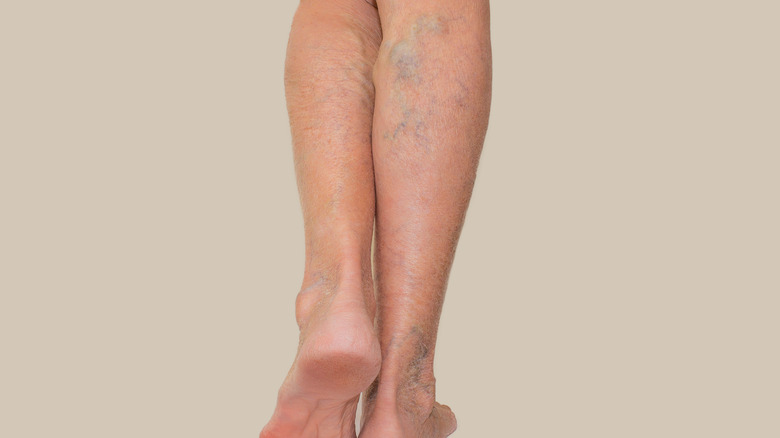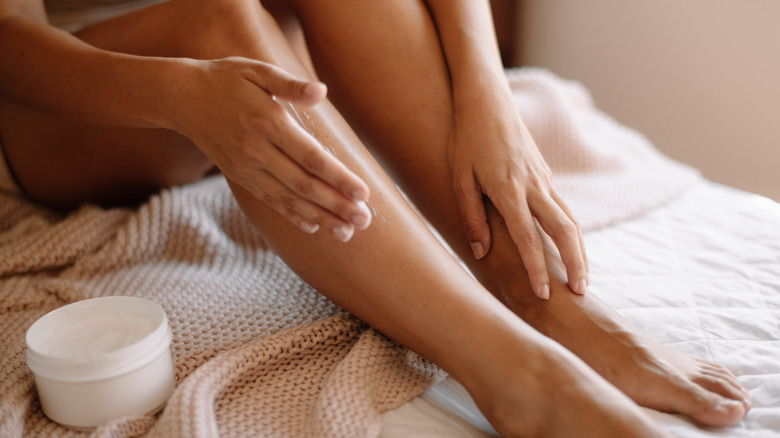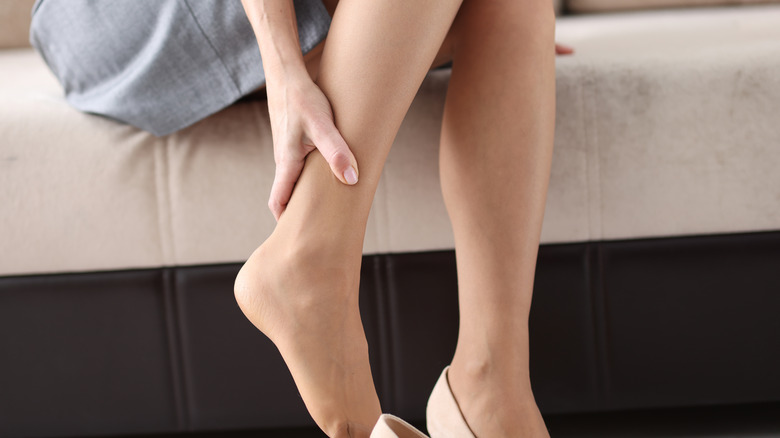Witch Hazel Can Do Wonders For Your Varicose Veins
Varicose veins, a condition that causes contorted, large veins, affect up to 40 million people in the United States. It's more likely to occur in people with a genetic disposition towards varicose veins, with about 20% of adults expected to develop the condition, according to the Institute for Quality and Efficiency in Health Care (via NCBI). Mainly occurring in the legs, varicose veins are caused by a spike in blood pressure in the veins, per MedlinePlus. Although the condition is most commonly found in older women, obesity, pregnancy, sitting or standing for extended periods of time, blood clots in the legs, and having defective valves can all lead to varicose veins.
Despite the twisted and gnarled appearance of the veins, they're typically harmless, according to the Mayo Clinic. When they do cause symptoms, they can manifest as swelling, burning, muscle cramping, changes in the skin color surrounding the veins, itching, and aching pain after sitting or standing. While the desire to remove varicose veins is purely for aesthetic purposes for some people, the pain they cause for others can be quite serious.
There are ways to get rid of varicose veins, but it's not always an option for some people. For an at-home method to lessen the symptoms of varicose veins, witch hazel might work.
Can you use witch hazel on varicose veins?
Derived from dried leaves, tree bark, and leaves, witch hazel is used for itching, inflammation, acne, and insect bites when applied topically. The astringent can also be taken orally for colds, fevers, diarrhea, and tumors, says WebMD. The multi-use liquid can be found in a range of products, from toners to shampoos, thanks to its anti-inflammatory nature. It works wonders on the skin and body, which is why some specialists recommend it for varicose veins.
Witch hazel is reported to strengthen blood vessels, according to the Center for Vein Restoration, which is why it's been used in the treatment of hemorrhoids — it's also what makes it ideal for varicose veins. The astringent won't reduce the appearance of your veins, but it can definitely help to soothe the painful symptoms they bring. To ease the symptoms, you can either apply witch hazel onto a washcloth and apply it onto the veins, or fill a tub with warm water and add in about 20 drops of witch hazel. There's no non-surgical cure for varicose veins, but this affordable hack can bring relief.
How to manage varicose veins
If varicose veins have started to form on your legs, there are a few actions you can take to reduce the symptoms that can potentially crop up later. For example, compression therapy is a non-invasive treatment that can help with varicose veins. By wearing compression socks when standing or sitting for long periods of time, you can decrease the amount of pressure that occurs in your veins.
Another way to manage your condition is by avoiding activities and clothing that put too much or too little strain on your legs. As described by the Mayo Clinic, exercising and moving about is important, but learn your limits — standing for too long can make the situation worse. You should also opt for low-platform shoes and clothes that aren't too tight, since this can restrict blood flow.
If your varicose veins result from strain on the legs due to weight, eating healthy and exercising may help you keep a healthy weight, per Azura Vascular Care. Eating less salt can help with this as well, since sodium causes swelling as a result of water retention, leading to heightened blood pressure, according to Hamilton Vascular. Many people that get varicose veins have a genetic predisposition for it, making it avoidable. However, this doesn't mean that you have to suffer as a result of it.


